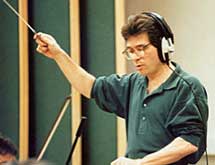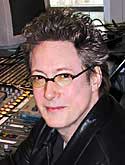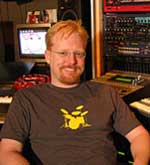|
Chances are
that when something moves you by either making you laugh or cry
while watching a movie or TV show, a musical
score
accompanies the scene. Music is a fundamental device that filmmakers
use to develop a mood, set up a character and move a scene along.
Music for animation has its own set of requirements, so we asked
four successful animation composers to give us a behind-the-scenes
peek at how they work. They talked with Animation World Magazine
about their working relationship with producers, directors and
creators, how they approach their work and what they think about
when writing a score.

Denis
M. Hannigan suggests that composers ask the producers
and directors very direct questions about their
musical likes and dislikes before composing.Photo
credit: Teri Hannigan.
|
Denis
M. Hannigan, Hooligan Music
Composer
for Rugrats, Recess, CatDog, Beakman’s World, Adventure
in Wonderland and the 2002 ASCAP Award Winner for Most
Performed Underscore. Being able to handle technical
issues and deadlines is another consideration for animation
composers. These issues could include short deadlines,
time code problems and which delivery mediums are required,
etc. I’ve had simultaneous projects, all with different
requirements. Experience working with live players is
very important too, if the producer/director wants the
feel of live musicians. This entails printing sheet music
and additional recording sessions and time.
A
director searching for a composer will first look at
how well the music complements the animation in the composer's
sample reel. An excellent sense of timing should be evident
-- the music should move the action forward, not slow
it down. Since story and dialogue are top priority, music
should support and enhance, rather than overpower these
essential elements. Versatility, writing for live players,
original sound palettes are important, but is the music
doing what it’s supposed to?
When talking to a director or creator about a new project, a composer needs
to ask some crucial questions: What musical direction are they looking for?
Do they have any examples? What’s the overall concept of the project
and who is the audience? Are there songs? Do they want a unique, original
sound palette or one from a specific genre like orchestral, rock, etc.?
Another important question to find out is how much music the director envisions
in the project. This can range anywhere from wall-to-wall music to a minimal
approach.
Composers and directors alike need to be aware of warning signs that indicate
the musical score is off. Sometimes the musical style seems to conflict rather
than enhance or contrast with the animation. When music is at its best, you
don’t think about it while you’re watching it -- unless it’s
a scene or project in which the music is being featured.
|

Don
Grady, conducting the London Symphony Orchestra,
feels composers should think of their target
audience as they begin to write. Photo courtesy
of London Symphony Orchestra.
|
Don
Grady
Emmy-nominated
composer for The New Adventures of Jonny Quest (Cartoon
Network), Magic English (a Disney series
scheduled for release in early ’03), the just released
two disc set of Beauty And The Beast -- The DVD (56 minutes
of original music for featurettes and game animation),
Nickelodeon’s Globehunters ,Walt Disney’s
Favorite Christmas Stories and music for numerous Disney
game animation DVD titles including Emperor’s
New Groove, Pocahontas and Peter Pan . Also, you might
recognize
Don as Robbie Douglas from My Three Sons , one of the
longest running series in television history.
Basically, there are five different types of music that
fit any given project: orchestra, production sound design
, contemporary/groove-orientated music, geographical,
or time/place kind of music or songs.
To me, those five areas generally cover the kinds of
music required on any given project. Having said all
that, a lot of producers/directors at first don’t
really know what they want. I don’t mean this as
a slam, but they’re not really sure. So they
rely on a composer and his instincts to come up with
stuff.
With regards to the relationship that happens between
a composer and a producer/director, each is different,
so you start writing for them . I was working for a
director and every time I went anywhere from about
the C in the
treble cleft above, she would complain about it. “Yeah
I really don’t like that harp there, and the strings,
they seem too high there.” So by the time I was
into the third film, everything was low and dark; she
just didn’t agree with any kind of harp, plucking
or piano. I happened to go to a party once, and she was
there, and I overheard her say to somebody that she had
had an incident when she was a kid. Her little brother
shot a cap-gun in her ear, and ever since then, she has
had this problem with this ear. Certain sounds buzz that
ear and bother her. I practically dropped my drink. I
grabbed her and said, “You never told me this!” She
said, “Well what does that have to do with anything?” And
I said, “You know the high harp and the piano and
the stuff above, that has everything to do with this.” It
was like BINGO. Now, there’s a good reason to get
out of the studio once in awhile and go to a party. Sometimes
it’s stuff that comes out of left field like that.
|

Jody
Gray feels it's important for a composer to find
a chemistry with the director or producer when
starting a new project. Photo credit: Bianca
Black.
|
Jody
Gray
Weekly composer
for Courage the Cowardly Dog , all online Looney Tunes
shorts (www.looneytunes.com), Cartoon Network’s
animated special Private Eye Princess (premiering November
29) and Stellaluna (spring 2003 release on Scholastic
Entertainment DVD/Video).
Chemistry, an overall sensibility and a shared comic
or dramatic sense are enormously important traits for
a composer and director to share. A director’s
ability to express him or herself in musical terms is
a big plus, as is a composer’s ability to “read” the
director. And a big love of the fluid, manic magic that
is animation is imperative.
When a producer or director of a project considers a
composer, he will first decide if that composer’s
music moves him. Be aware that a composer’s reel
is made up of what he or she has already done, often
reflecting the style, taste and input of another director
or producer. It shows what you did -- not always what
you’re capable of doing. The reel may open a door
but I find that scoring a minute or two of picture for
a new director is extremely helpful. Kinda puts you all
on the same page quickly and gets an immediate creative
dialogue going.
When a composer starts a new project, he should get the
director/creator/ producer to talk in depth about the
project. Ask what kind of music they envision for the
project, then sit back and be the most astute of listeners!
|

James
L. Venable warns that a composer should make
sure a scene works better with music than without.
Photo credit: Sophia Venable.
|
James
L. Venable
Film composer for The Powerpuff Girls Movie , weekly
composer for Samurai Jack and The Powerpuff Girls TV
series for the Cartoon Network, Clerks the Cartoon ,
and the upcoming fall MTV cartoon series, 3 South.
I want the directors that I work with to know that they
have a composer who will listen to them and can handle
anything. I also strive to be a composer who will help
the director realize his or her vision and is open to
changes. I would say when selecting a composer, keep
an open mind, try new people! Also, be open to hearing
the many sides of a composer's music. Composers can wear
many musical hats; this is a good thing, something that
animation often demands, so meet with them or at least
talk with them to get to know what they are comfortable
with musically. I was very fortunate to have found this
open mindedness in Kevin Smith and Scott Mosier, who
hired me to score Jay and Silent Bob Strike Back after
we worked together on Clerks the Cartoon . I wouldn’t
have gotten Clerks the Cartoon if it wasn’t for
former Disney music exec. Bambe Moe taking the time to
listen to the demo of a new guy with few credits. If
Craig McCracken and Genndy [Tartakovsky] weren’t
open minded, I wouldn’t have become the Powerpuff
and Samurai Jack composer. So, needless to say, I am
a big fan of open mindedness in directors/creators/executive
producers.
At the beginning of a project, the executive producers/creators/directors
should have a creative conversation with the composer
and ask him or her to put together a reel that is more
specific to the project that they are all working on.
If you have a scene, perhaps you can arrange to have
the composer score it. This is a low pressure, inexpensive
way to actually work together. A “general reel” can
be a good way to hear what a composer is most proud of,
but I find “specific” demos to be more effective.
I think those in charge of looking for composers need
to listen for music that moves them on an emotional level.
I recommend to directors/creators/producers to remember
that they hired a musical expert, so be sure to listen
to what the composer has to offer; it might be something
better than you even considered.
Darlene Chan is managing editor of Animation World Magazine
. After receiving a bachelor's degree from UCLA, Darlene
happened into the motion picture business and stayed
for 14 years. She served as a production executive for
Paramount Pictures, Walt Disney Pictures, Davis Entertainment
and Motown. She produced Grumpy Old Men (1993) for Warner
Bros. In 2000, she joined Animation World Magazine.
Note: Readers may contact any Animation World Magazine
contributor by sending an e-mail to editor@awn.com .
|
|